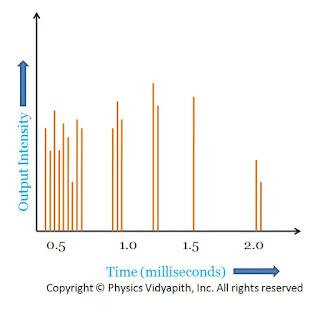Characteristics of Ruby Laser →
Some of the characteristics of ruby laser are given as follows:
- Ruby laser is the first working laser that was developed in 1960.
- Ruby lasers are three-level solid-state pulsed lasers with pulse lengths of the order of a millisecond.
- This laser uses a synthetic Ruby crystal that is Aluminium oxide as its gain medium.
- A triply ionized chromium $$Cr^{+3} is used as a dopant for active ion, concentration bring of the order of $0.055%$.
- Ruby crystals are hard and durable, chemically stable and it has good thermal conductivity.
- Ruby lasers are optically pumped using a flash lamp.
- In a ruby laser, water or liquid nitrogen is used as a coolant.
- These lasers produce pulses of visible light at wavelength $6928A^{\circ}$ and $6943A^{\circ}$, with $6943A^{\circ}$ as dominant wavelength which is a deep red color.
- Ruby laser is highly temperature-dependent.
- A practical ruby laser operates at about $1%$ efficiency.
- Pulse repetition rate is comparatively low, of the order of $1$ to $2$ pulse per second.
The Advantages of Ruby Laser →
Some advantages of ruby laser are mentioned below:
- Ruby laser is very easy to construct and operate.
- A very strong and intense laser beam up to an output power of $10^{4}- 10^{6} W$, is generated in this laser.
- It has a degree of coherence.
- Ruby crystal is hard, durable and it has good thermal conductivity and coherence length.
- It is chemically very stable.
- The laser crystal can be grown with a high degree of optical quality.
The disadvantage of Ruby Laser →
Following are some disadvantages of Ruby laser:
- Ruby cannot be grown in large dimensions.
- Ruby laser is less directional and has very small efficiency.
- High excitation energy is required as more than half of the active centers are to be excited to achieve population inversion
- It has a very small operation for only a few hours.
- producers pulsed output of microsecond duration($\approx30 \mu s$).
- Very high heat is produced in these lasers due to which an effective cooling system is required.
- In these lasers, only a small part of pumping power is utilized in the excitation of chromium ion $Cr^{+3}$ and the rest goes to heat up to apparatus.
Applications of Ruby Laser →
Ruby laser have declined in use with the discovery of a better lasing medium but they are still used in a number of applications some of which are given as follows:
- These lasers are used in optical holography to produce holographic portraits, in size up to a meter square.
- These lasers are used in tattoo and hair removal but are being replaced by other lasers.
- These lasers are used in the measurement of plasma properties such as electron density temperature etc.
- These lasers are used where short pulses of red light are required.
- These lasers are used in labs to create holograms of large objects such as aircraft tires to look for weaknesses in the lining.
Spiking in Ruby Laser →
 |
| Spiking in Ruby Laser |
Ruby laser is a three-level pulsed laser. The operation of ruby laser leads to a pulsed output with flash lamps as pumping source. The output of a ruby laser is found to consist of a series of pulses of duration of a microsecond or less. The output of this laser is a highly irregular function of time with the intensity having random amplitude fluctuation of varying duration as shown in the figure. These pulses of the short duration are called spikes and the phenomenon is called laser spiking. Duration of individual spikes is of the order of $0.1-1 \mu s$, the time interval between two adjacent spikes is about $1-10 \mu s$. The power of each spike is of the order of $10^{4}- 10^{5} W$. The characteristic spiking of ruby laser
The Characteristic Spiking of Ruby Laser →
When the pumping source (flash lamp) is turned on the population at the upper level gradually increases while the population at the lower energy level decreases. The duration of the exciting flashlight is of the order of milliseconds and may be sufficiently intense to build up population inversion very rapidly. As soon as the population at the upper level becomes sufficiently large and the threshold condition is reached, laser action starts producing a laser pulse. Due to laser pulsed emission population of upper laser level is depleted more rapidly than it can be restored by flashlight. This process leads to leads to an interruption of laser oscillations, the laser oscillation ceases for a few microseconds. Because the flash lamp is still active it again builds up population inversion and laser oscillations beings causing other spikes and the sequence is repeated. A series of pulses is thus produced itself till the intensity of the flashlight has fallen below the threshold value due to which it is not possible to rebuild the necessary population inversion and the lasing action stops.





